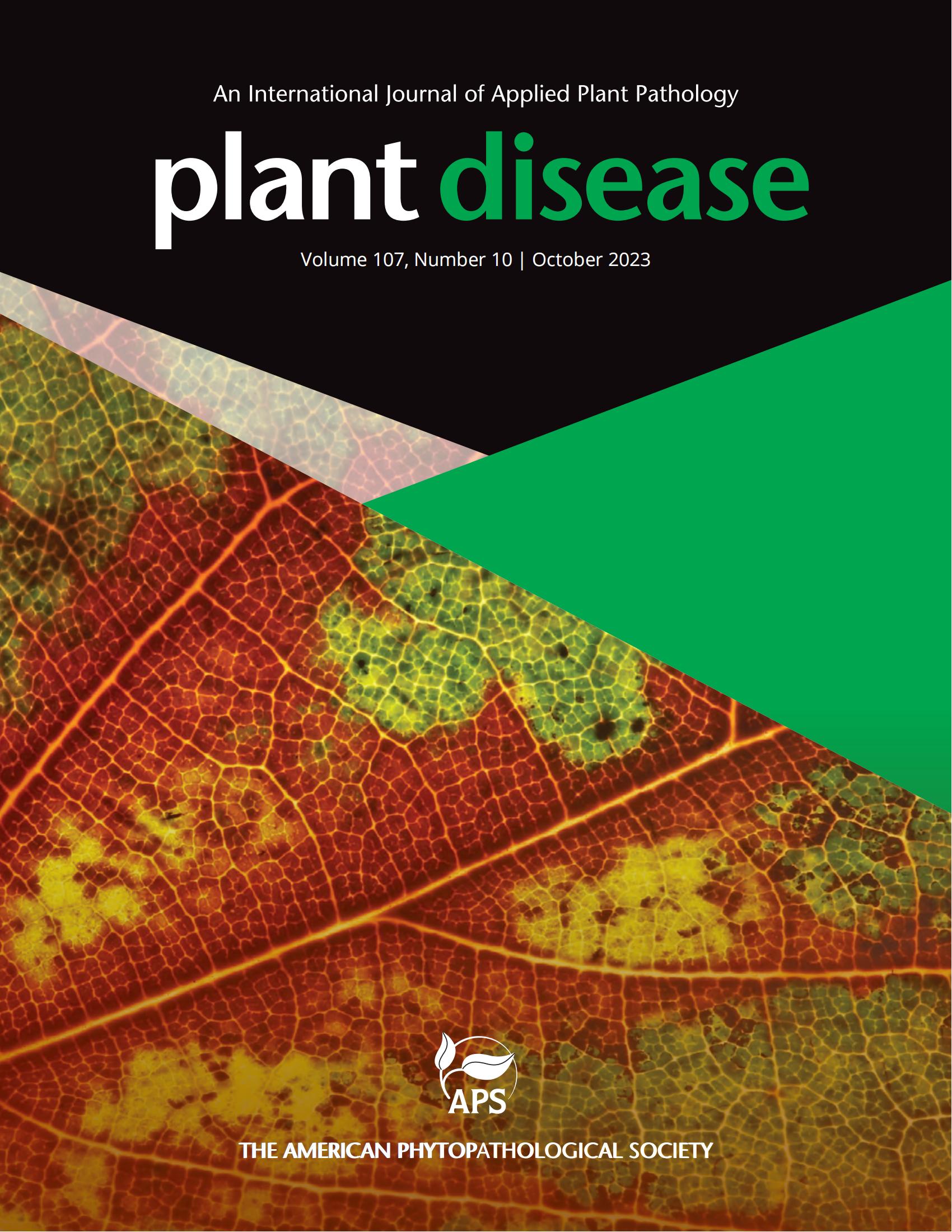新英格兰地区首次报告由 Colletotrichum siamense 引起的草莓炭疽冠腐病。
摘要
2023 年夏天,康涅狄格州南部的一个农场与康涅狄格州农业试验站取得了联系,原因是该农场的草莓(Fragaria × ananassa)植株出现了严重枯萎和树冠腐烂的迹象,涉及多块田地,面积约 20 公顷。从病株上切下的树冠上有大理石般的红色和白色病斑,这通常与炭疽病冠腐病(ACR)有关。从四个不相邻的田块中收集了五个六月生栽培品种(AC Valley Sunset、Lyla、Dickens 和 Allstar 等品种)的病株,发病率为 5-90%,严重程度从低发病率田块的轻度枯萎到高发病率田块的严重枯萎/死亡不等。病冠内部组织在 0.6% NaOCL 溶液中表面消毒 3 分钟,用无菌水冲洗干净,然后移栽到马铃薯葡萄糖琼脂上。一周后,真菌的顶端被转移到新鲜的平板上,形成由蓬松的灰白色菌丝组成的致密菌丝垫。菌落中心附近形成橙色的孢子块,每个孢子块都含有大量圆柱形和纺锤形的直分生孢子,与 Colletotrichum 属的孢子相匹配(De Silva 等人,2019 年)。分生孢子(n=192)的平均长度为 15.7 ± 1.6 微米,宽度为 5.4 ± 0.7 微米。从 83% 采集到的有症状的树冠中分离出了符合这一形态的真菌,并从 CT5-1 和 CT23-1 这两个分离物中采集了菌丝,使用 GeneJET 植物基因组 DNA 纯化试剂盒进行 DNA 提取。使用针对肌动蛋白(ACT)、钙调蛋白(CAL)、β-微管蛋白(TUB2)、GAPDH(gpdA)和 ITS 的引物进行 PCR,然后进行 Sanger 测序,结果发现两个分离株(CT5-1 编号:PP002078-81、OR999066)的序列完全相同(Carbone 和 Kohn,1999 年;Hassan 等,2018 年;Templeton 等,1992 年)。这些序列与来自 14 个 Colletotrichum 基因组的序列相结合,所有序列均使用 Mega11(Tamura、Stecher 和 Kumar,2021 年)进行了对齐、修剪和连接。使用 IQ-TREE 对模型进行了选择,并使用所选参数从所有五个位点单独生成最大似然树,并对序列进行了合并,所有这些都将分离株与 Colletotrichum siamense 放在一个高置信度聚类中(Nguyen 等,2015 年)。为确认病原体的致病性,裸根移植五周后的草莓植株(cv. Jewel)(n=5)受到感染。用无菌的 20 µL 移液管吸头刺入每个树冠基部 5 毫米深,然后接种 10 µL 的孢子,孢子浓度为 106 个/毫升。对照植株(n=5)接种 10 µL 无菌水。植物在生长室中保持 30°C 白天(16 小时)/20°C 夜间(8 小时)的温度,14 天后进行评估。接种的五株植物中有四株出现了明显的枯萎症状,被切成两半的树冠上出现了典型的 ACR 红白相间的大理石纹病斑。对照植株没有明显的枯萎症状,切开的树冠明显健康。从感染组织中重新分离出的 C. siamense 具有相同的菌丝/孢子形态,ITS/Tub2 被重新扩增和测序,得到的序列与 CT5-1 相同。对同一品种的植物进行重复接种,其症状发展和树冠病变完全相同。C. siamense 一直是整个美国东南部地区 ACR 的主要来源,但以前在东北部并不是主要问题。鉴于田间感染的程度,这些分离物很可能能在新英格兰地区较低的冬季温度下存活,但要确定病原体的耐寒程度,还需要进一步的实验。In the summer of 2023, the Connecticut Agricultural Experiment Station was contacted by a farm in southern Connecticut due to reports of strawberry (Fragaria × ananassa) plants showing signs of severe wilting and crown rot across multiple fields, covering ~20 hectares. Cut crowns from diseased plants had marbled red and white lesions typically associated with anthracnose crown rot (ACR). Symptomatic plants were collected from five June-bearing cultivars (cvs. AC Valley Sunset, Lyla, Dickens, and Allstar) spanning four non-adjacent fields with incidence ranging from 5-90% and severity ranging mild wilting in low incidence fields to severe wilting/mortality in high incidence fields. Internal tissue from diseased crowns was surface sterilized in 0.6% NaOCL for 3 minutes, rinsed with sterile water, and plated on potato dextrose agar. After one-week, hyphal tips of fungi were transferred to fresh plates which formed dense mycelial mats of fluffy, greyish-white hyphae. Orange spore masses formed near the center of the colonies, each of which contained numerous cylindrical and fusiform straight conidia, matching spores within the genus Colletotrichum (De Silva et al. 2019). Average conidia (n=192) length was 15.7 ± 1.6 µm and width was 5.4 ± 0.7 µm. Fungi matching this morphology were isolated from 83% of the collected symptomatic crowns and hyphae were collected from two isolates, CT5-1 and CT23-1, for DNA extraction using the GeneJET Plant Genomic DNA Purification Kit. PCR was performed using primers targeting actin (ACT), calmodulin (CAL), β-tubulin (TUB2), GAPDH (gpdA), and ITS, followed by Sanger sequencing, which yielded identical sequences for both isolates (CT5-1 Accessions numbers: PP002078-81, OR999066)(Carbone and Kohn 1999; Hassan et al. 2018; Templeton et al. 1992). These were combined with sequences from fourteen Colletotrichum genomes, all of which were aligned, trimmed, and concatenated using Mega11 (Tamura, Stecher, and Kumar 2021). Model selection was conducted using IQ-TREE and selected parameters were used to generate maximum-likelihood trees from all five loci individually and the concatenated sequence, all of which placed the isolates in a high confidence cluster with Colletotrichum siamense (Nguyen et al. 2015). To confirm the pathogenicity of the pathogen, strawberry plants (cv. Jewel) (n=5) five weeks after bare root transplant were infected. The base of each crown was penetrated 5 mm deep with a sterile 20 µL pipette tip and then inoculated with 10 µL of spores at a concentration of 106 spores/mL. Control plants (n=5) were inoculated with 10 µL of sterile water. Plants were maintained at 30°C day (16-hour)/20°C night (8-hour) in a growth chamber and assessed after 14-days. Four of the five inoculated plants had visible wilt symptoms and bisected crowns revealed the marbled red and white lesions typifying ACR. Control plants had no clear wilting and bisected crowns were visibly healthy. C. siamense re-isolated from infected tissue presented with identical hyphal /spore morphology and ITS/Tub2 were re-amplified and sequenced, yielding identical sequences to CT5-1. Plant inoculations with the same variety were repeated, yielding identical symptom development and crown lesions. C. siamense has been a dominant source of ACR throughout the southeastern US but has not previously been a major problem in the Northeast. Given the extent of the field infection, it is likely that these isolates can survive the colder winter temperatures of New England, but further experimentation is necessary to determine the extent of the pathogen's winter hardiness.

 求助内容:
求助内容: 应助结果提醒方式:
应助结果提醒方式:


